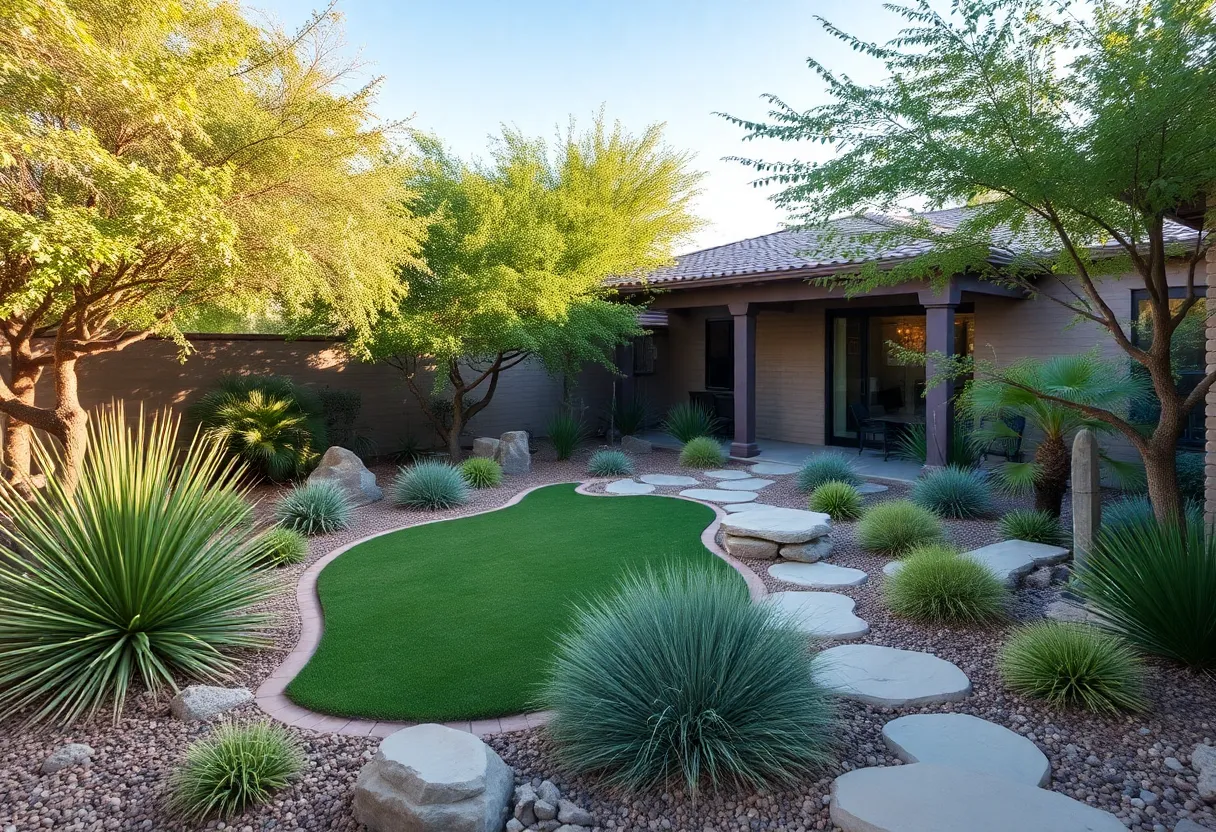Landscaping in Phoenix Requires Thoughtful Planning to Combat the Intense Heat and Arid Conditions
Creating a sustainable, comfortable outdoor space in Phoenix demands strategic planning tailored to the region’s severe climate. The tana of scorching temperatures and minimal rainfall calls for innovative landscaping solutions that balance aesthetic appeal with environmental resilience. This comprehensive guide explores seven proven design elements to help you design a yard that not only survives but thrives amid the desert heat.
1. Embrace Xeriscaping with Native Plants
Understanding Xeriscaping
Xeriscaping is a landscape design philosophy focused on reducing water use through concepts like drought-tolerant plants, efficient irrigation, and strategic layout. In Phoenix’s environment, xeriscaping minimizes water waste while maintaining visual interest and ecological harmony.
Incorporating Native Plants
Native plants are inherently adapted to the local climate, requiring less water, fertilizer, and maintenance. Key choices include saguaro, agave, ocotillo, and desert marigold. These species provide resilience against drought, pest resistance, and specific aesthetic qualities. Using native flora helps create a landscape that is functional and beautiful without heavy resource inputs.
2. Install Shade Structures
The Importance of Shade
Reducing outdoor temperatures is vital in Phoenix. Installing shade structures such as pergolas, trellises, or shade sails significantly lowers ambient heat, making outdoor spaces more inviting during peak sun hours.
Design Strategies
Positioning these structures to maximize shade during the hottest parts of the day enhances comfort. Climbing plants like wisteria, jasmine, or climbing roses can transform these frameworks into natural canopy covers, adding both shade and visual interest.
3. Utilize Reflective and Light-Colored Materials
Material Selection for Cooler Outdoors
Light-colored paving options such as travertine, slate, and concrete with lighter finishes reflect solar radiation instead of absorbing it. This reduction in heat absorption leads to cooler surfaces and creates a more comfortable environment.
Design Benefits
Using reflective materials for walkways, patios, and borders enhances aesthetic appeal and minimizes heat buildup. Modern finishes further improve durability and ease of maintenance in high-temperature settings.
4. Incorporate Water Features with Stone Accents
Cooling Naturally
Water features such as fountains, small ponds, or cascades introduce evaporative cooling, naturally lowering nearby air temperatures. When combined with natural stone elements, these features blend seamlessly into desert-inspired landscapes.
Enhancing Visual Appeal
Using travertine or slate as accents around water features gives a tactile, earthy quality that complements native materials. The soothing sound of flowing water adds tranquility, making outdoor spaces more relaxing amid heat waves.
5. Implement Efficient Irrigation Systems
Water Conservation Strategies
Installing drip irrigation systems is critical for delivering water directly to plant roots, reducing evaporation and runoff. Efficient systems provide consistent moisture and minimize waste, particularly during peak heat periods.
Mulching for Moisture Retention
Applying organic or inorganic mulch around plants further conserves soil moisture, suppresses weeds, and moderates soil temperature. Proper mulch use complements drip irrigation and enhances overall water efficiency.
6. Create Outdoor Living Spaces
Designing Comfortable Retreats
Designing shaded, furnished outdoor areas encourages usage during cooler parts of the day. Incorporate comfortable seating arrangements, shade structures, and outdoor lighting to produce inviting spaces conducive to relaxation and entertainment.
Indoor-Outdoor Connection
Creating seamless transitions between indoor and outdoor spaces extends comfort beyond the home interiors, making your yard a natural extension of your living area. Strategically placed lighting, rugs, and weather-resistant furniture enhance usability during evening hours.
7. Choose Drought-Tolerant and Low-Maintenance Plants
Plant Selection
Opt for plants such as succulents, cacti, and native shrubs. These species are adapted to survive in minimal water conditions, requiring less maintenance and fostering a resilient landscape.
Aesthetic and Functional Value
Native drought-tolerant plants introduce diverse textures, colors, and structural interest. They also help create a landscape that is environmentally sustainable, visually compelling, and easy to care for, addressing the region’s water scarcity issues.
Conclusion
Designing a landscape in Phoenix that effectively manages the region’s extreme heat and arid conditions requires informed choices. By leveraging native plants, integrating shade structures, employing reflective materials, and utilizing efficient irrigation, homeowners can craft outdoor spaces that are both beautiful and sustainable. Incorporating water features, creating comfortable outdoor living areas, and selecting robust, drought-tolerant plants further enhance resilience. Ultimately, thoughtful planning transforms a harsh desert landscape into a cool, inviting outdoor retreat that withstands the demands of Phoenix’s climate.
Frequently Asked Questions
What is xeriscaping, and why is it suitable for Phoenix?
Xeriscaping is a landscape approach focused on reducing water use through drought-tolerant plants, efficient irrigation, and strategic design. It is ideal for Phoenix due to its extremely dry climate and minimal rainfall, helping conserve water while maintaining aesthetic appeal.
How can shade structures improve outdoor comfort in Phoenix?
Shade structures like pergolas, trellises, and shade sails block direct sunlight, significantly reducing outdoor temperatures. They create cooler, more inviting spaces during intense sunlight hours and can be enhanced with climbing plants for natural canopying.
What materials help reflect heat in desert landscapes?
Light-colored materials such as travertine, slate, and reflective concrete surfaces help bounce sunlight away from surfaces, reducing heat absorption and creating cooler outdoor environments.
Why are native plants beneficial for Phoenix landscapes?
Native plants are naturally adapted to the desert climate, requiring less water, fertilizer, and maintenance. They are resilient, pest-resistant, and contribute to local biodiversity, making them ideal for sustainable landscaping in Phoenix.
Key Features of Heat-Resilient Landscaping in Phoenix
| Feature | Benefit | Implementation |
|---|---|---|
| Xeriscaping with Native Plants | Reduces water consumption, enhances resilience | Choose drought-tolerant native flora suited for desert conditions |
| Shade Structures | Lower outdoor temperatures, increase comfort | Install pergolas, trellises, or shade sails, incorporate climbing plants |
| Reflective Surfaces | Minimize heat absorption, keep surfaces cooler | Use light-colored paving, travertine, and reflective finishes |
| Water Features with Stone Accents | Natural evaporative cooling, aesthetic appeal | Integrate fountains with natural stone elements like slate or travertine |
| Efficient Irrigation & Mulching | Water conservation, soil moisture retention | Implement drip irrigation, add mulch around plants |
| Outdoor Living Spaces | Extended usability, comfort during cooler times | Design shaded seating areas with lighting and weather-resistant furniture |
| Drought-Tolerant Plants | Low maintenance, structural diversity | Plant succulents, cacti, native shrubs suited for low water use |
Author: STAFF HERE PHOENIX WRITER
The PHOENIX STAFF WRITER represents the experienced team at HEREPhoenix.com, your go-to source for actionable local news and information in Phoenix, Maricopa County, and beyond. Specializing in "news you can use," we cover essential topics like product reviews for personal and business needs, local business directories, politics, real estate trends, neighborhood insights, and state news affecting the area—with deep expertise drawn from years of dedicated reporting and strong community input, including local press releases and business updates. We deliver top reporting on high-value events such as the Waste Management Phoenix Open, Cactus League Spring Training, and Arizona State Fair. Our coverage extends to key organizations like the Greater Phoenix Chamber of Commerce and Visit Phoenix, plus leading businesses in technology and healthcare that power the local economy such as Intel and Banner Health. As part of the broader HERE network, including HERETucson.com, we provide comprehensive, credible insights into Arizona's dynamic landscape.





